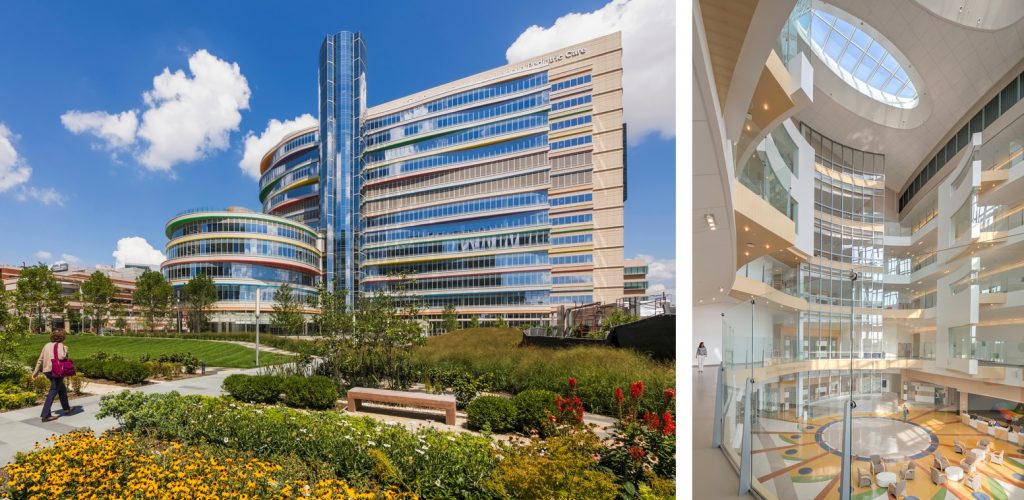In a deal announced this morning, Houston-based healthcare and S+T design specialist FKP has merged with design giant CannonDesign (#8 on BD+C’s Giants 300 Top 100 Architecture/Engineering Firms ranking). The merger forms a 19-office, 960-employee practice that produced more than $220 million in combined design revenue in 2016.
Led by CEO Diane R.K. Osan, FAIA, ACHA, FKP is an internationally recognized design firm with offices in Houston, Dallas, and Columbus. Known for its expertise in pediatric healthcare, the firm has designed children’s facilities throughout the U.S., including Nemours’ A.I. DuPont Hospital for Children in Wilmington, Del., the Children’s Hospital of Philadelphia’s Buerger Center for Advanced Pediatric Care in Philadelphia, and numerous projects for Texas Children’s Hospital.
“CannonDesign’s five-year strategic framework focuses on proactive strategies for strengthening our client partnerships through personal and firm growth by office expansions, new hires, and mergers,” said CannonDesign’s CEO Brad Lukanic, AIA, in a statement. “Today’s merger with FKP intentionally increases CannonDesign’s commitment to total health solutions with a focus on children’s health, while advancing our design impact, being a top-tier employer, and taking a stronghold in key geographic areas like Texas and Ohio.”
Reflecting on the shared benefits of the merger, Osan notes the opportunity to profoundly impact community health. “In order to effectively improve the conditions of our communities, we have to start by addressing the needs of children. Not just healthcare for children, but education, research, recreation, nutrition and that list goes on. All of these factors are critical in setting the path for a child’s future, and our firms’ combined expertise will allow us to address these factors and set children and communities up for success.”
Osan will assume the role as leader of CannonDesign’s Pediatric Health Practice. Looking beyond the traditional definition of healthcare, she will lead the practice in exploring ways to support the health and wellbeing of children across numerous environmental settings. She’ll also be joining the firm’s board of directors.
“Both of our firms have solid foundations,” added Lukanic. “Now we can expand in key areas to further serve our clients and create partnerships to evolve our design practice.”
Going forward, FKP will conduct business as FKP | CannonDesign.
Related Stories
| Nov 2, 2010
A Look Back at the Navy’s First LEED Gold
Building Design+Construction takes a retrospective tour of a pace-setting LEED project.
| Nov 2, 2010
Wind Power, Windy City-style
Building-integrated wind turbines lend a futuristic look to a parking structure in Chicago’s trendy River North neighborhood. Only time will tell how much power the wind devices will generate.
| Nov 2, 2010
Energy Analysis No Longer a Luxury
Back in the halcyon days of 2006, energy analysis of building design and performance was a luxury. Sure, many forward-thinking AEC firms ran their designs through services such as Autodesk’s Green Building Studio and IES’s Virtual Environment, and some facility managers used Honeywell’s Energy Manager and other monitoring software. Today, however, knowing exactly how much energy your building will produce and use is survival of the fittest as energy costs and green design requirements demand precision.
| Nov 2, 2010
Yudelson: ‘If It Doesn’t Perform, It Can’t Be Green’
Jerry Yudelson, prolific author and veteran green building expert, challenges Building Teams to think big when it comes to controlling energy use and reducing carbon emissions in buildings.
| Nov 2, 2010
Historic changes to commercial building energy codes drive energy efficiency, emissions reductions
Revisions to the commercial section of the 2012 International Energy Conservation Code (IECC) represent the largest single-step efficiency increase in the history of the national, model energy. The changes mean that new and renovated buildings constructed in jurisdictions that follow the 2012 IECC will use 30% less energy than those built to current standards.
| Nov 1, 2010
Sustainable, mixed-income housing to revitalize community
The $41 million Arlington Grove mixed-use development in St. Louis is viewed as a major step in revitalizing the community. Developed by McCormack Baron Salazar with KAI Design & Build (architect, MEP, GC), the project will add 112 new and renovated mixed-income rental units (market rate, low-income, and public housing) totaling 162,000 sf, plus 5,000 sf of commercial/retail space.
| Nov 1, 2010
John Pearce: First thing I tell designers: Do your homework!
John Pearce, FAIA, University Architect at Duke University, Durham, N.C., tells BD+C’s Robert Cassidy about the school’s construction plans and sustainability efforts, how to land work at Duke, and why he’s proceeding with caution when it comes to BIM.
| Nov 1, 2010
Vancouver’s former Olympic Village shoots for Gold
The first tenants of the Millennium Water development in Vancouver, B.C., were Olympic athletes competing in the 2010 Winter Games. Now the former Olympic Village, located on a 17-acre brownfield site, is being transformed into a residential neighborhood targeting LEED ND Gold. The buildings are expected to consume 30-70% less energy than comparable structures.
| Oct 27, 2010
Grid-neutral education complex to serve students, community
MVE Institutional designed the Downtown Educational Complex in Oakland, Calif., to serve as an educational facility, community center, and grid-neutral green building. The 123,000-sf complex, now under construction on a 5.5-acre site in the city’s Lake Merritt neighborhood, will be built in two phases, the first expected to be completed in spring 2012 and the second in fall 2014.















